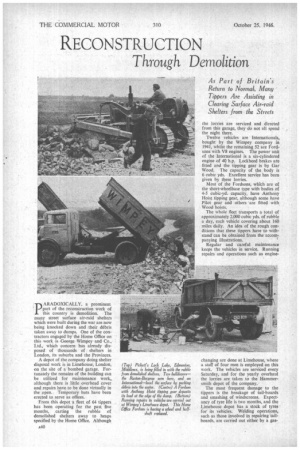RECONSTRUCTION Through Demolition
Page 50

Page 53

If you've noticed an error in this article please click here to report it so we can fix it.
pARADOXICALLY, a prominent part of the reconstruction work of this country is demolition. The many street surface air-raid shelters which were built during the war are now being knocked down and their debris taken away to dumps. One of the contractors engaged by the Home Office on this work is George Wirnpey and Co., Ltd., which concern has already disposed of thousands of shelters in London, its suburbs and the Provinces.
A depot of the company doing shelter disposal work is in Limehouse, London, on the site of a bombed garage. Fortunately the remains of the building can be utilized for maintenance work, although there is little overhead cover and repairs have to be done virtually in the open. Temporary huts have been erected to serve as offices.
From this depot a fleet of 64 tippers has been operating for the past five months, carting the rubble of demolished shelters away to heaps specified by the Home Office. Although the lorries are serviced and directed from this garage, they do not all spend the night there.
Twelve vehicles are Internationals, bought by the Wimpey company in 1941, whilst the remaining 52 are Fordsons with VS engines. The power unit of the international is a six-cylindered engine of 40 h.p. Lockheed brakes are fitted and the tipping gear is by Gar Wood. The capacity of the body is 6 cubic yds. Excellent service has been given by these lorries.
Most of the Fordsons, which are of the short-wheelbase type with bodies of 4-5 cubic-yd. capacity, have Anthony Hoist tipping gear, although some have Pilot gear and others are fitted with Wood hoists.
The whole fleet transports a total of approximately 2,000 cubic yds. of rubble a day, each vehicle covering about 160 miles daily. An idea of the rough conditions that these tippers have to withstand can be obtained from the accom7 panying illustrations.
Regular and careful maintenance keeps the vehicles in service. Running repairs and operations such as engine changing are done at Limehouse, where a staff of four men is employed on this work. The vehicles are serviced every Saturday, and for the yearly overhaul the lorries are taken to the Hammersmith depot of the company.
The most frequent damage to the tippers is the breakage of tail-boards and smashing of windscreens. Expectancy of tyre life is two months, and the Limehouse depot has a stock of tyres for its vehicles. Welding operations, such as those involved in repairing tailboards, are carried out either by a gas welding plant or Hercules petrol-electric apparatus.
After a shelter has been knocked down by a Ruston-Bucyrus machine, known as the "basher," an excavator of the same make scoops up the debris and drops it into the body of a waiting lorry, which, when full, drives to a dump. There is no waiting by the excavator for a truck to load, for as soon as one lorry has gone another takes its place.
At a dump at Pickett's Lock, Edmonton, Middlesex, a lake is gradually being filled in with rubble. This dump was started at the end of August, and since then more than 65,000 cubic yds. of debris have been tipped here.
Lorries arrive throughout the day, tipping their loads at the edge of the dump. Two bulldozers, one an International and the other a Ruston-Bucyrus, level off the surface, pushing the rubble into the water.
The vehicles are doing extremely useful work in removing objects that are both unsightly and a4lindrance to traffic. Another vital need in national reconstruction is the building of houses, in which the Wimpey fleet may be expected to play an even more important role.












































































